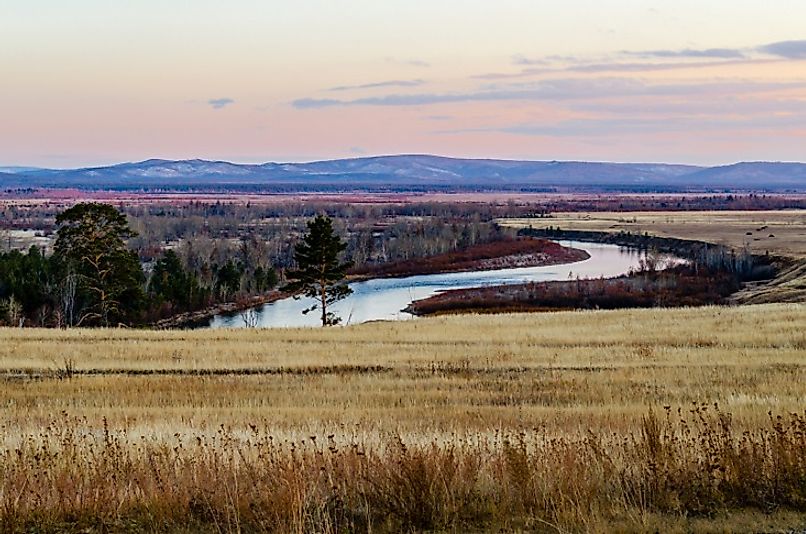The Selenga River

5. Description
The Selenga River is a trans-boundary river flowing northeastwards through Mongolia and into Russia. Its origins are in the mountainous regions of Mongolia, and its largest tributary there is the Orkhon River. The Selenga River is the main tributary of Lake Baikal, the largest freshwater lake in the world, found in southern Siberia near Russia’s border with Mongolia. The river has an estimated length of 616 miles, according to the United States' National Aeronautic and Space Administration publications. The Selenga River and its tributaries contribute around 80 percent of Lake Baikal’s watershed, according to a Geoscience News and Information report. Its other tributaries are the rivers Dzhida, Orkhon, Khanui, Chikoy, Khilok and Uda, according to the Baikal Basin Information Center. According to the Institute of General and Experimental Biology Institute of General and Experimental Biology, Siberia, the river carries 3.5 million tons of sediment into Lake Baikal.
4. Historical Role
The continued flow of the Selenga River into Lake Baikal formed the river’s delta around 25 million years ago, according to the International Ecological Educational Center (IEEC) in Baikal, Siberia. This is one of the only freshwater deltas in the world. The Selenga River Delta has acted as a natural filter that removes natural and manmade substances from Russian and Mongolian waters alike. During the 10.0-magnitude Tsagan earthquake on New Year's Eve on the 1st of January, 1862, the triangular Proval Bay in the northeastern part of the Selenga River Delta, was formed due to the sedimentation that occurred. As a result of the earthquake, four villages went underwater as the 15-meter deep Proval Bay was being formed. The bay is one of 132 in the world formed due to a natural geological movement, according to the Baikal Information Center.
3. Modern Significance
The Selenga River Basin occupies 19.2 percent of Mongolia’s land area, according to the Korean Environment Institute. Hence, it’s a vital water resource to the country. Its waters are used for agricultural irrigation, household water supply, mining, recreation, tourism, and transportation. Tourists also love to visit the Selenga River and Lake Baikal. Expeditions and other activities available there include boat rides to explore the delta and its wetlands, kayaking, rafting, and birdwatching in the delta. Tourists also are afforded the opportunity to marvel at the picturesque river formations within the delta as they approach Lake Baikal. These formations appear like a multi-branch fan sprawled about the Selenga Delta.
2. Habitat
Across the entire span of the Selenga River Basin are crisscrossed three distinct vegetation types in Mongolia and Russia. These are boreal, forest-steppe, and steppe, according to the Institute of General and Experimental Biology Institute of General and Experimental Biology, Siberia.The delta is itself a vibrant habitat, with over 170 bird species therein, many of which migratory. As a vital wetland, it’s been designated as a UNESCO World Heritage and a Ramsar Convention on Wetlands site. There are also 70 rare or endangered plants and animal species living there according to Geoscience News and Information. The Selenga Delta is also a fish nursery and migratory route stop for many fish, some of which are fished commercially. These include Graylings, Cisco, and the rare Baikal sturgeons. The Selenga River Delta is the largest river in the Lake Baikal catchment area according to RAMSAR.
1. Threats and Disputes
In recent years, the entire Selenga River Basin, including Lake Baikal, has experienced significant water pollution, which has been a problem brought about by and in large due to increased industrialization in the region. The basin’s ecosystems have also faced threats from unregulated tourism, irresponsible resource exploitation, human encroachment, and climate change, according to the International Union for the Conservation of Nature. Tensions and disputes have also began between Russia and Mongolia over the latter country’s plan to construct two dams on the Orkhon and Selenga Rivers, according to Rivers without Boundaries. According to researchers, such a construction would damage the Selenga River ecosystem as the dams would hinder the migration of aquatic species, decrease downstream supply of sediments vital to sustaining the river delta habitat, and distort natural flows of Lake Baikal’s main tributary, the Selenga River. Such a construction is also projected to affect the livelihoods of human populations in Russia and Mongolia who engage in such varied sectors as livestock farming, fisheries, and transportation in, around, and along the river.







